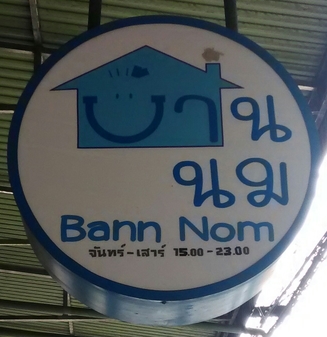ม (m) and น (n) look rather similar to บ (b) but notice they both have an extra loop. Both start with a small circle at the top left and can be drawn without removing pen from paper. ม is circle, down, loop, across, and up. น is circle, down, across, loop, and up.
You need a way of remembering which is which: m is before n in the alphabet, and the 2nd loop in ม is drawn before the 2nd loop in น.
The good news is that ม and น always sound like m and n wherever they appear in a word.
We can now write a few simple words. In this and future lessons, these ‘reading practice words’ are listed roughly in order of usefulness or frequency of use.
- มา (maa) = to come (note that in Thai, verbs don’t change depending on whether it is I, you, (s)he, etc.)
- ทาน… (taan) = to eat … (ทาน is always followed by the word for food or rice or whatever is being eaten)
- นาน (naan) = a long time
- บน (bon) = on
- นม (nom) = milk (or breast – normally obvious which from context!)
- ทน (ton) = to endure
- นา (naa) = rice field; farm
- บาน (baan) = to bloom; (window) pane
The ‘o’ sound in บน, นม, or ทน is short. Strictly, it is like very short versions of the French ‘eau’ or, less accurately, the ‘o’ in ‘go’. But in practice, you can also say it like the ‘o’ in ‘on’ (said with a standard British accent); the two sound almost the same and no confusion will arise – the important thing is that the ‘o’ sound is very short. Whenever a word is written with just two consonants, this extra ‘o’ sound in between is implied.
